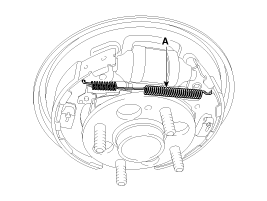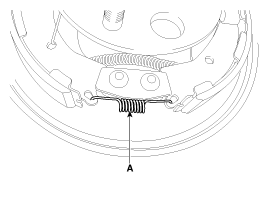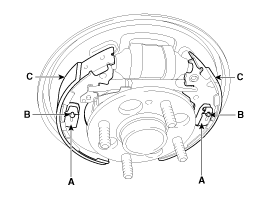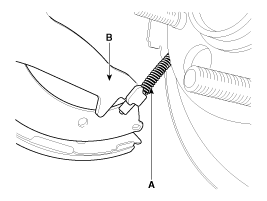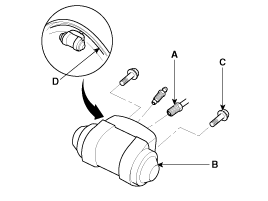 Hyundai Accent: Removal
Hyundai Accent: Removal
|
| 1. |
Release the parking brake.
|
| 2. |
Remove the rear wheel & tire.
|
| 3. |
Remove the rear brake drum (A).
|
| 4. |
Remove the upper return spring (A).
|
| 5. |
Remove the lower return spring (B).
|
| 6. |
Remove the shoe hold springs (A) and shoe hold pins (B) and then
remove brake shoe (C). Make sure not to damage the dust cover on the
wheel cylinder.
|
| 7. |
Remove the parking brake cable (A) and then remove brake shoe
(B).
|
| 8. |
Disconnect brake tubes (A) from the wheel cylinder (B).
|
| 9. |
Remove the bolt (C) and the wheel cylinder (B) from the backing
plate (D).
|
 Installation
Installation
•
Do not spill brake fluid on the vehicle: it may damage
the paint; if brake fluid does conta ...
See also:
Components(2)
[5 Door]
1. Roof trim
2. Retainer
3. Sunvisor
4. Assist handle
5. Assist handle bracket
...
Anchor Pretensioner (APT). Description and Operation
Description
Front anchor pretensioner operates as well as Belt Pretensioner at the
same time If it gets into its deploy condition after a collision. It is located
at near anchor on driver se ...
Front Body A ( 4Door )
Hood hinge mounting hole (Ø10)
Fender apron upper member tooling
hole (Ø6.6)
Front shock ...
Hyundai Accent Manuals
- Hyundai Accent 2017-2022 Service Manual
- Hyundai Accent 2010-2025 Owners Manual
- Hyundai Accent 2010-2025 Service Manual
© 2011-2025 Copyright www.hamanual.com


